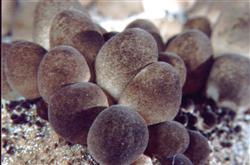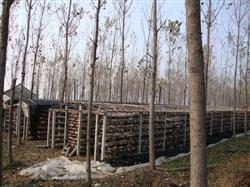How to plant Auricularia auricula?

How to plant Auricularia auricula? Please guide the middle and high temperature fungus of Auricularia auricula, which can adapt to a wide range of temperature; the primary fruiting body is cup-shaped and gradually grows into an ear shape, and many ear pieces are connected in the shape of chrysanthemum; the diameter is generally 10 cm-20 cm, and when dried, it strongly shrinks into horny, hard and brittle; the back of the fruiting body is raised, with short villi, and the surface is smooth or wrinkled. The color varies with variety and planting method, showing dark brown, light brown, light yellow and so on. At present, there is a shortage of yellow-backed fungus on the market. The main points of its cultivation techniques are introduced as follows: first, the best ear season of Auricularia auricula should be from the Beginning of Summer to the Autumn Equinox. Therefore, bacterial bag culture (it takes 40 days from inoculation to full bacteria) can be planted after the Spring Festival. If the planting volume is large, it can start one month before the Spring Festival. Bacterial bags full of mycelium should be strictly protected from freezing before the Spring Festival. after the Spring Festival, you can build a sunshade behind the house or on the open land, surrounded by grass curtains on all sides. When placing the bacterial bag, there needs to be a certain gap between the row and the platoon. The bacterial bag can be covered with a woven bag, and the bacterial bag full of mycelium is not afraid of rain. If it doesn't rain in spring, spray water as appropriate. 2. The varieties with strong mycelium growth, early ear emergence, strong resistance, short growth period, good shape and high yield were selected, such as Shanghai No. 3, 781, 952 and so on. 3. According to the carbon-nitrogen ratio needed for the growth and development of Auricularia auricula, the culture materials can be selected in situ according to the local superior resources. The commonly used bag formula is: ① cottonseed shell, sawdust and corncob each account for 1 stroke 3, sugar 1%, lime powder 2%. ② cotton husk 25%, corncob 35%, sawdust 36%, sugar 1%, gypsum powder 1%, lime powder 2%. Fourth, in the production of bacterial bag, soak the corncob in lime water in advance, then add sawdust, cottonseed shell and various auxiliary materials, and mix well. The moisture should be mastered for 4 hours after mixing, and the water can be obtained by clenching the finger seam of the culture material. After sterilization, the ph value is 6ml 6.5. If there is any difference, adjust the amount of lime. It is forbidden to add carbendazim, topiramate and other pesticides to the culture material. The specification of the plastic bag is 20cm × 42cm (each bag can hold 800 grams of dry material and 150 grams of dry ears). The bag should be loose and tight, and the mouth rope should be tied tightly. After atmospheric pressure sterilization reached 100 ℃, it was kept for 12 hours. The bacteria were sterilized with formaldehyde or potassium permanganate. Don't crumple the bacteria, but don't have large chunks either. Properly increase the amount of inoculation and make the bacteria cover the material surface preferentially, which can effectively prevent the invasion of miscellaneous bacteria and reduce the bad bags. Warm inoculation should be rushed in early spring and cool in late spring. 5. Management of germ period (1) greenhouse and temperature: in the first few days after entering the room, the room temperature must reach 25 ℃-28 ℃, so that the strain can germinate and colonize as quickly as possible under the best conditions. After the mycelium was sent out, the temperature dropped to 18 ℃-22 ℃. At this temperature, the mycelium was white and strong, and the yield was high. As far as temperature is concerned, the temperature in the first few days determines the success rate, and the later temperature determines the output. (2) Light and ventilation: the light should be dim. Light is an important factor in the formation of fruiting bodies. By controlling the intensity of light, we can control the formation of fruiting bodies and reduce nutrient consumption. Auricularia auricula is an aerobic fungus, which needs sufficient oxygen in the whole process of growth and development, so it should be ventilated regularly and ventilated twice a day. The outside temperature is high in spring, so you can choose to ventilate at night. (3) check miscellaneous bacteria in time: bacterial bags are often contaminated by miscellaneous bacteria, so check them in time and handle them gently to prevent the bag wall from being damaged. If the harm of rats is found in the greenhouse, lime should be applied in time to cover the surface of the bacterial bag with a layer of lime to prevent the harm. Click to get more Auricularia auricula planting techniques
- Prev

How to prevent the death of straw mushroom?
How to prevent the death of straw mushroom? Please give an introduction to prevent the death of straw mushroom can refer to the following methods for prevention and treatment: first, poor ventilation straw mushroom is a high-temperature aerobic fungus, the growth and development process needs enough oxygen. In the process of cultivation, in order to increase the stack temperature, sometimes the film covering time is too long, making the second in the material stack.
- Next

How to cultivate Auricularia auricula in summer forest?
How to cultivate Auricularia auricula in summer forest? Please give guidance to Auricularia auricula under normal conditions, but at present, after some first stubble ears are harvested, they are infected with miscellaneous bacteria without waiting for 2 stubble ears to grow, resulting in a reduction in the yield of 2-3 stubble ears, or even no production, affecting the benefit. First, the reason for the contamination of subbatch ear miscellaneous bacteria: ⑴.
Related
- Fuxing push coffee new agricultural production and marketing class: lack of small-scale processing plants
- Jujube rice field leisure farm deep ploughing Yilan for five years to create a space for organic food and play
- Nongyu Farm-A trial of organic papaya for brave women with advanced technology
- Four points for attention in the prevention and control of diseases and insect pests of edible fungi
- How to add nutrient solution to Edible Fungi
- Is there any good way to control edible fungus mites?
- Open Inoculation Technology of Edible Fungi
- Is there any clever way to use fertilizer for edible fungus in winter?
- What agents are used to kill the pathogens of edible fungi in the mushroom shed?
- Rapid drying of Edible Fungi

